 Canada has many bumblebee species, including:
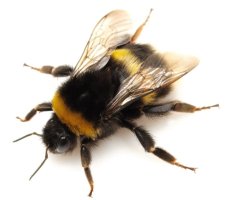 The greatest bumblebee diversity is in British Columbia, Alberta, and the Yukon. Alpine meadow regions are especially important bumblebee habitats. Of the over 200 known bumblebee species worldwide, approximately 50 are found in North America.
The greatest bumblebee diversity is in British Columbia, Alberta, and the Yukon. Alpine meadow regions are especially important bumblebee habitats. Of the over 200 known bumblebee species worldwide, approximately 50 are found in North America.
Bumblebees are beneficial social insects known for pollinating crops and wild plants. Bumblebees are annual nesters that build new nests each spring as opposed to reusing ones from the previous year. The bumblebee differs in appearance from most bees found in Canada. They are relatively large, measuring between 15 and 25 mm in length. Bumblebees have black bodies covered in black, yellow, and sometimes orange hairs, which form a banded pattern and the fuzzy appearance typical of bumblebees. 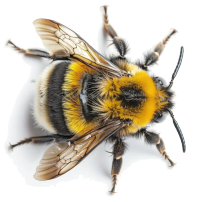 Bumblebees need a varied diet to survive. Flowering plants are the most common food source. The bee takes nectar from flowers, and the sweet, sugary carbohydrate acts as fuel. Bumblebees also eat pollen, which is the main source of protein in their diet. Larvae eat a combination of pollen, nectar, honey, and other floral oils, sometimes called bee bread.
Bumblebees need a varied diet to survive. Flowering plants are the most common food source. The bee takes nectar from flowers, and the sweet, sugary carbohydrate acts as fuel. Bumblebees also eat pollen, which is the main source of protein in their diet. Larvae eat a combination of pollen, nectar, honey, and other floral oils, sometimes called bee bread.
Bumblebees are not aggressive insects, only becoming a problem when provoked. The insects typically only sting when defending the nest. Unlike other bee species however, bumblebees can sting more than once, as the stinger is smooth, contains no barb, and typically will not fall off or get stuck in the skin. The sting of a bumblebee may be quite painful, more so than that of a honeybee. 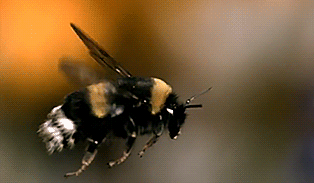 It was once thought that flying should be impossible for the relatively heavy and distictly un-aerodynamic bumblebee.
However, a 2005 study gathered data using high-speed photography of actual flying bees, as well as force sensors on larger-than-life robotic bee wings flapping around in mineral oil. It was discovered that bumblebees flap their wings back and forth, rather than up and down. Here's the explanation of what keeps them in the air:
It was once thought that flying should be impossible for the relatively heavy and distictly un-aerodynamic bumblebee.
However, a 2005 study gathered data using high-speed photography of actual flying bees, as well as force sensors on larger-than-life robotic bee wings flapping around in mineral oil. It was discovered that bumblebees flap their wings back and forth, rather than up and down. Here's the explanation of what keeps them in the air:"The fluid dynamics behind bumblebees' flight are different from those that allow a plane to fly. An airplane's wing forces air down, which in turn pushes the wing (and the plane it's attached to) upward. For bugs, it isn't so simple. The wing sweeping is a bit like a partial spin of a somewhat crappy helicopter propeller, but the angle to the wing also creates vortices in the air like small hurricanes. The eyes of those mini-hurricanes have lower pressure than the surrounding air, so, keeping those eddies of air above its wings helps the bee stay aloft."Researchers are now interested in the finer points of how insects control themselves once they're in the air. Those studies will be especially important for a fleet of robotic insects in development, including 'robobees' created by a team at Harvard University. 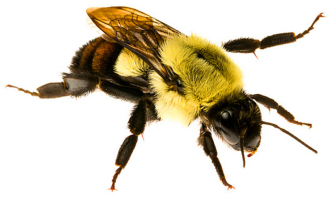 The Common Eastern Bumblebee:
The Common Eastern Bumblebee:The Common Eastern bumblebee is the most commonly encountered bumblebee across much of eastern North America. Because of their great adaptability, they can live in the country, suburbs, and even cities. They are considered one of the most important species of pollinator bees in North America. These bumblebees have underground nests that are up to a metre below ground. They enter their nests using tunnels that can be 3 metres long. Unlike the nests of honeybees or paper wasps, the nests of the Common Eastern bumblebee do not have a predictable pattern. The bees lay egg clumps all over inside the nest, instead of in one brood area. The foragers improve their foraging activity by communicating with others in their nests. They share their abilities to associate scents of good food sources. In addition, forager bees use a strategy called 'traplining', in which the bees visit their food sources in a repeatable sequence, to improve their efficiency. The bees establish traplines by searching among flowers in an orderly manner. Upon establishment, the traplines remain stable for long periods of time. Traplining has many advantages. The bees can minimize both the distance traveled by linking the sources in a direct path, and the time spent searching by knowing the locations of food sources. Also, the bees can pass over locations that have been depleted of resources, saving energy and time. 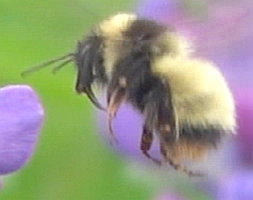 The Active Bumblebee:
The Active Bumblebee:The Active bumblebee is a species of bumblebee that is native to the tundra of northern Canada and Alaska. They are active for many months of the year, from late winter to fall. They nest underground. Bumble bees in the high Arctic use their flight muscles to keep themselves warm. Not a lot is known about this species, including what type of plants they visit. Climate change is considered a primary threat to this bumblebee due to its high elevation and high latitude habitats. 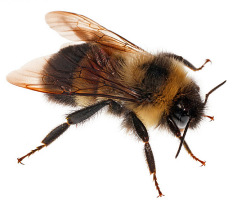 The Rusty-patched Bumblebee:
The Rusty-patched Bumblebee:The Rusty-patched Bumblebee's range is throughout the east and upper midwest of the United States, and north to Ontario, Canada. In 2017, the United States Fish and Wildlife Service placed this bumblebee on the list of endangered species, making the Rusty-patched bumblebee the first bee to be added to the list in the continental United States. Until the 1980s, it was one of the most common species of bumblebee in southern Ontario; since then, the species has had a drastic decline in numbers and is now difficult to find in its normal range. These bumblebees are relatively large in size, and like other species, are known to be eusocial organisms. Most nests are built underground, and are commonly found in old rodent burrows. Rusty-patched bumblebees require three different types of habitats, for foraging, nesting, and hibernating, which are close to one another, making this species particularly vulnerable to extinction. Although they require a temperate climate, they can withstand cold temperatures that most species of bumblebees cannot. They actively forage between April and October. Queens overwinter underground, or burrow into rotting logs to survive. As with most bumblebees, solitary queens emerge in spring and begin searching for a colony, while also collecting nectar and pollen to feed her future brood. The queen uses sperm she has saved from her mating activities of the previous fall to fertilize her eggs, which hatch in about four days but take up to 5 weeks to become completely developed adults. In the first few weeks after laying her brood, the queen is solely responsible for feeding her young. However, shortly afterwards, her female worker offspring begin collecting food for the colony in preparation for more offspring. Once the workers are able to become the primary caretakers of the nest, the queen can focus on laying more eggs. At this point (which is about halfway through the summer), the number of workers reaches an optimal number and the queen begins producing males and potential new queens. Colony sizes can range from 50 to 400 individuals. 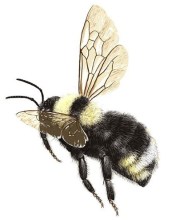 The Gypsy Cuckoo Bumblebee:
The Gypsy Cuckoo Bumblebee:The Gypsy Cuckoo bumblebee can be found in diverse habitats, including open meadows, mixed farmlands, urban areas, and boreal forests. It is a social parasite, and does not have the typical colony cycle of other bumblebees, and therefore does not produce workers. Mated females emerge in the spring and look for potential host nests. The female kills or subdues the host queen and lays eggs that the host colony workers tend. In the late summer and autumn, females and males emerge from the host nest and leave to mate. Mated females then select an overwintering site. Like other bumblebees, the males and the egg-laying female of that generation die at the onset of cold weather. The Gypsy Cuckoo bumblebee had an extensive range in Canada, in all provinces and territories except Nunavut. However, there has been a large observed decline in relative abundance in the past 20-30 years in areas of Canada where the species was once common. |